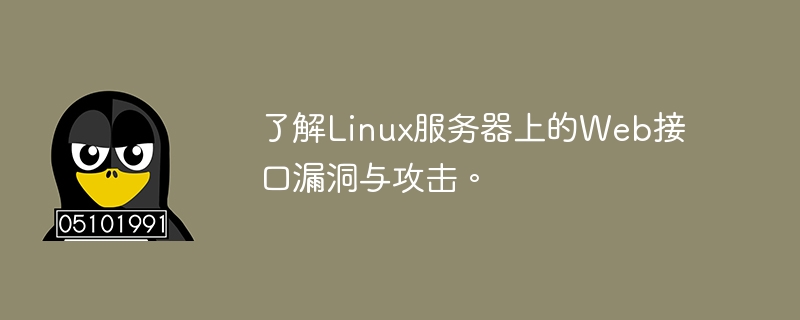

Understand Web interface vulnerabilities and attacks on Linux servers
With the rapid development of the Internet, Web applications have become an important information transmission and interaction method for enterprises and individuals. . As one of the most common hosting platforms for web applications, Linux servers have also become a key target for hacker attacks. Web interface vulnerabilities and attacks are one of the most common security issues on Linux servers. This article will explore several common web interface vulnerabilities and attack methods, and give corresponding code examples.
1. SQL injection attack
SQL injection is one of the most common web interface vulnerabilities. Hackers inject special SQL statements into the data submitted by users to control the database to perform unauthorized operations, thereby obtaining, modifying or deleting sensitive data. The following is a simple code example:
import pymysql
def login(username, password):
db = pymysql.connect("localhost", "root", "password", "database")
cursor = db.cursor()
sql = "SELECT * FROM users WHERE username = '%s' AND password = '%s'" % (username, password)
cursor.execute(sql)
data = cursor.fetchone()
db.close()
return data In the above code, the received username and password are directly used to construct a SQL query statement by string concatenation. . Such code is vulnerable to SQL injection attacks, and hackers can bypass login verification by inserting malicious code in username or password.
To avoid such attacks, parameterized queries or ORM frameworks should be used to ensure that input data is escaped and processed correctly. Modify the code as follows:
import pymysql
def login(username, password):
db = pymysql.connect("localhost", "root", "password", "database")
cursor = db.cursor()
sql = "SELECT * FROM users WHERE username = %s AND password = %s"
cursor.execute(sql, (username, password))
data = cursor.fetchone()
db.close()
return data2. File upload vulnerability
The file upload vulnerability means that the uploaded files are not properly checked and filtered, causing hackers to upload malicious files into the server. Hackers can gain server permissions by uploading malicious web shells, perform arbitrary operations, and even control the entire server. The following is a simple code example:
<?php
$target_dir = "uploads/";
$target_file = $target_dir . basename($_FILES["fileToUpload"]["name"]);
$uploadOk = 1;
$imageFileType = strtolower(pathinfo($target_file,PATHINFO_EXTENSION));
// 检查文件类型
if($imageFileType != "jpg" && $imageFileType != "png" && $imageFileType != "jpeg"
&& $imageFileType != "gif" ) {
echo "只允许上传图片文件.";
$uploadOk = 0;
}
// 检查文件大小
if ($_FILES["fileToUpload"]["size"] > 500000) {
echo "抱歉,文件太大.";
$uploadOk = 0;
}
// 保存上传文件
if ($uploadOk == 0) {
echo "抱歉,文件未上传.";
} else {
if (move_uploaded_file($_FILES["fileToUpload"]["tmp_name"], $target_file)) {
echo "文件上传成功.";
} else {
echo "抱歉,文件上传失败.";
}
}
?>In the above code, the type of uploaded files is not accurately judged and filtered. Hackers can bypass restrictions by modifying the file type and upload malicious files. To avoid such attacks, uploaded files should be properly verified and filtered, limiting the file types and sizes that are allowed to be uploaded.
3. Cross-Site Scripting Attack
Cross-Site Scripting (XSS) refers to hackers injecting malicious scripts into Web pages to obtain users’ personal information or conduct Other illegal operations. The following is a simple code example:
<?php $user_input = $_GET['input']; echo "<p>" . $user_input . "</p>"; ?>
In the above code, the content input by the user is directly output, without processing and filtering the user input. Hackers can implement XSS attacks by constructing malicious scripts. To avoid such attacks, user input should be properly processed and filtered, using escape functions or HTML filters.
This article introduces common web interface vulnerabilities and attack methods on Linux servers, and gives corresponding code examples. To ensure the security of web applications, developers should be aware of the existence of these vulnerabilities and take corresponding protective measures to improve server security.
The above is the detailed content of Understand web interface vulnerabilities and attacks on Linux servers.. For more information, please follow other related articles on the PHP Chinese website!
 What are the data analysis methods?
What are the data analysis methods?
 Why can't my mobile phone make calls but not surf the Internet?
Why can't my mobile phone make calls but not surf the Internet?
 What are the css3 gradient properties?
What are the css3 gradient properties?
 What is the article tag used to define?
What is the article tag used to define?
 Win10 does not support the disk layout solution of Uefi firmware
Win10 does not support the disk layout solution of Uefi firmware
 How to create a web page in python
How to create a web page in python
 python configure environment variables
python configure environment variables
 What are the design patterns used by laravel?
What are the design patterns used by laravel?
 How to use union in c language
How to use union in c language




